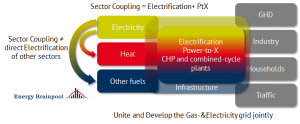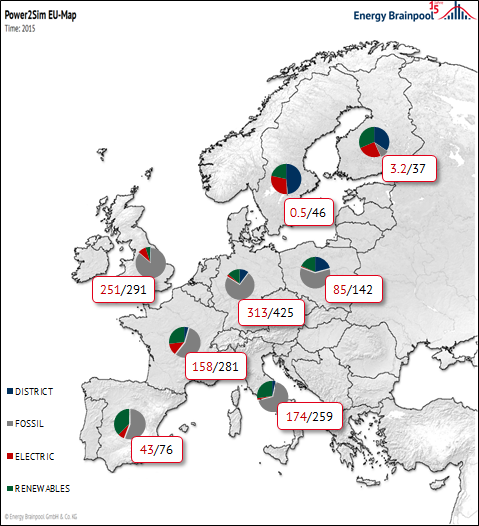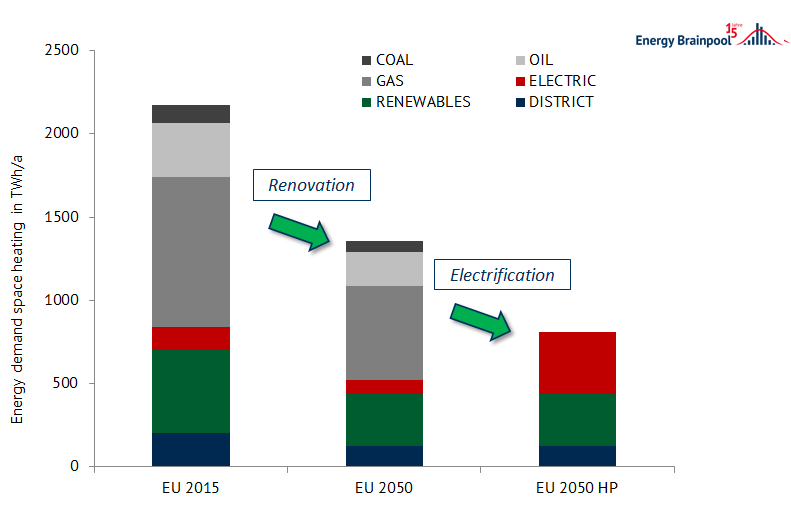The term sector coupling is used four times in the coalition agreement between CDU/CSU and SPD forming the new German government. This article analyses the key points of the new German government in terms of sector coupling and presents key figures and scenarios for the European heating markets.

Our energy system will be facing major changes in the coming decades. These developments will be driven in particular by the expansion of fluctuating renewable energies and the need for greenhouse gas emission reductions.
Sector coupling and the future energy system
Sector coupling comprises the combination of the previously largely independent electricity, mobility and heat sectors. It promises to create added value for climate protection and the efficient use of energy through electrification of numerous applications. The supply of raw materials for industrial processes (hydrogen or carbon-based compounds) is also often regarded as an important point in sector coupling. During this introductory article, the latter will not be considered further.
The most important connections and the definition of sector coupling have already been elaborated on in a previous article. The ideas on the coupling of the electricity, mobility and heating sectors written down in coalition agreement of the new German government are to be considered here first. Also part of this article: the status quo and an outlook for the heating sector, Germany’s largest energy consumer.
A more in-depth look at the topic of sector coupling, in particular technological, economic and regulatory developments, will take place in our seminar “Sector Coupling and Electrification” on 3rd of May 2018 in Berlin (also offered as in-house trainings in English).
What does the coalition agreement say?
The first mention of sector coupling in the coalition agreement is in the section on “Research and Innovation”. Specifically, it is about research on system solutions for the sector coupling of electricity-transport-heat. A detailed design of this agenda will require consortia from industry and research to test not only the technical feasibility of technologies in pilot projects. In particular, the integration of sector coupling technologies into the overall energy system and the expected added values in terms of emission reduction must be considered here. This is already being tested in part in the projects of the programme “Smart Energy Showcases – Digital Agenda for the Energy Transition” (SINTEG). It was funded by the Federal Ministry for Economic Affairs and Energy. Exemptions from certain regulations, especially with regard to cost components of the various energy sources, are a necessary implementation in order for the projects to function.
This is also specifically pointed at in the second mention of sector coupling in the “Energy” section of the coalition agreement. The coupling of the three sectors is to be promoted in connection with storage technologies. “To do this, the framework conditions must be adapted.” (“Source: Coalition agreement”) Up to now, a number of price components in the electricity sector do not allow the energy carrier electricity to economically compete with fossil fuels such as gas or oil, even though electricity is increasingly a decarbonised energy source in Germany.
New challenges: Redistribute costs in the electricity system
The challenge facing the coalition partners here is therefore to redistribute the costs of the electricity system (promotion of renewable energies, grid charges, electricity tax, etc.) to other sectors. In short: How can decarbonised electricity become economically competitive with fossil fuels for sector coupling applications? Will there be exceptions for electricity price components for certain uses of electricity? If so, at what level and for what technologies? Is there a time limit to the exceptions? And who bears the cost of these exceptions? These are questions that the Grand Coalition must address.
In the same chapter, the coalition agreement speaks of a reformation of the planning and financing of energy infrastructures. Up to now, the electricity and gas network development plans have been drawn up and approved largely independently of each other. In an even more interconnected energy system such a separated approach will no longer work: Planning of electricity, gas and heating networks has to occur in an integrated approach. Since energy infrastructure is being used for long periods of time, concepts for joint network development plans must be developed at an early stage.
Sector coupling and transport
In the “Transport” section of the coalition agreement, the National Innovation Programme Hydrogen and Fuel Cell Technology and the Mobility and Fuel Strategy are to be continued and further developed. Sector coupling, for example in the form of “green hydrogen”, is also to be promoted here. To this end, the regulatory framework is to be adapted. The future energy system will be more strongly interconnected. This must be taken into account by adapting the regulatory framework. There will be no way around changing or redistributing the cost of electricity price components if electricity is to be increasingly used in the mobility and heating sectors.
Where is the heating sector heading to?
With as much final energy consumption as the electricity and mobility sectors combined, the heating market is the largest consumer of energy. In 2016, final energy consumption in the heating sector was around 1400 TWh in Germany. With almost 50 per cent of total heat consumption, space heating plays the most important role. In other European countries, the distribution of heat consumption between space heating, process heat and hot water is somewhat different than in Germany. As shown in Figure 1, a large proportion of household heating requirements are met by fossil fuels throughout Europe. Only in the Nordic countries of Sweden and Finland fossil fuels account for a very small share of the household heating energy supply. Renewables cover some part of the heat supply as well. District heating (the origin of the heat in district heating is not specified further) is more prominent in the northern countries.

Figure 1: Final energy consumption for space heating in households 2015 for selected European countries in TWh (Data source: Eurostat survey households (space heating 2015))
In Germany, about 75 per cent of household heating requirements, i.e. 425 TWh, are covered by fossil fuels. Electricity currently plays hardly any role, while renewable energies and district heating each cover around 10 per cent of demand.
What does it take for the heat turn?
The decarbonisation of heat generation in residential buildings in Europe is an important step towards CO2-free energy supply. In particular, the final energy consumption can be reduced by renovating existing building stock. Accordingly, less energy will have to be provided by renewable energy sources or electricity-based heat generators to cover the heat demand. Figure 2 shows the level of heating demand for space in households in Europe in 2015. In addition, the figure shows possible changes in space heating requirements and the provision of energy for ambitious renovation targets and large-scale electrification with heat pumps.

Figure 2: European household demand for space heating in 2015 (Data source: Eurostat survey households (space heating 2015)), in a renovation scenario and a subsequent electrification scenario
Currently, fossil fuels cover 60 per cent of European households’ heating requirements. With ambitious plans for building renovation and refurbishment, the heating requirement could be reduced by 40 per cent by 2050 (if no rebound effects occur). This is an immense task against the background of current renovation rates.
With a “fuel switch”, away from fossil fuels to electricity-related applications such as heat pumps, the energy requirement can be reduced by an additional 40 percent. In return, the European electricity demand for the heating sector would increase by about 290 TWh per year. This corresponds to about eight per cent of Europe’s total power generation in 2016.
Developments in the area of sector coupling, be it in e-mobility or in the heating sector, are very important for achieving CO2 savings targets. In order to be prepared for the future, more interconnected energy markets, the technological, economic and regulatory developments should be monitored.



